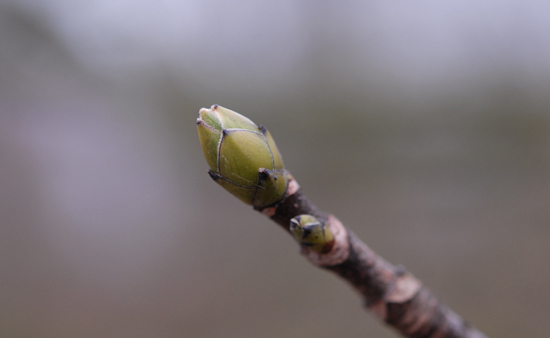
Bark & Buds: How to Easily Identify 12 Common European Deciduous Trees in Winter
- When the woods are bare of leaves, you have to look to other features for tree identification.
I love roaming the woods in late winter and early spring and I’d encourage anyone who loves the outdoors to do the same. It’s a great time of year to be out. I’ve noticed, however, that without leaves to refer to, people often find it hard to identify deciduous trees in the winter.
For those of us who have an interest in bushcraft or survival skills, we need to be able to identify resources all year round. Bark is an obvious feature to look at but in most cases, bark shows more variety and is harder to differentiate than the leaves of different species.
Buds are often associated with spring, whereas they lie dormant all winter, waiting for spring. So they are present throughout the time we need them to help us identify the tree.
This article provides some key identifying features in the form of bark and buds to help you recognise 12 common European deciduous trees. I’ve included trees with wide geographical ranges and I have consciously limited the article to a dozen distinct species so as not to provide information overload.
Sycamore – Acer pseudoplatanus
- Bark of Sycamore, Acer pseudoplatanus. Photo: Paul Kirtley
The Sycamore is commonly found in the forests, woods and field boundaries of western Europe and eastwards across to the Crimea and Caucasus region. Sycamore is widely naturalised outside of this native range. Some in Britain and Northwestern Europe consider it an insidious weed.
The bark of young Sycamore trees is usually smooth and silvery-grey but sometimes brown. As the tree ages, the bark develops cracks, later having large peeling scales scales of 10-20cm by 5-10cm (4-8 x 2-4 in).
Sycamore’s buds are arranged in opposite pairs. They are egg-shaped with a pointed end, green in colour and the tips of the bud scales are brown, 0.5-1cm (0.2-0.4 in).
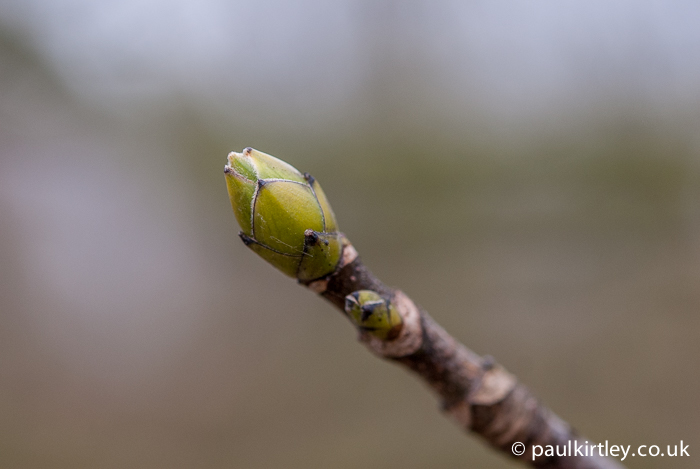
Common Ash – Fraxinus excelsior
- In mature trees the bark of Ash, Fraxinus excelsior, can resemble oak. Photo: IKAl
Seen frequently all over Europe and east to the Caucasus, Ash is a common tree. Ash can be found growing in forests, in hedges and on open hillsides. Indeed, Ash is often found at higher altitudes than most other large broadleaved trees. When Ash grows amongst other broadleaved trees it is often the tallest tree in the forest.
The buds of Ash are arranged in opposite pairs, rounded except for the termial buds (the buds at the end of shoots and branches) which are more cone shaped. The key identifying feature of the buds of F. excelsior is that they are black or very dark, looking sooty. Also note how the ends of shoots curve upwards. You can spot this from a long way off, before you even see what colour the buds are.
Ash bark is smooth grey or a pale grey-brown in young trees. In older trees the bark becomes fissured into interwoven ridges and can resemble the bark of Oak (see below).
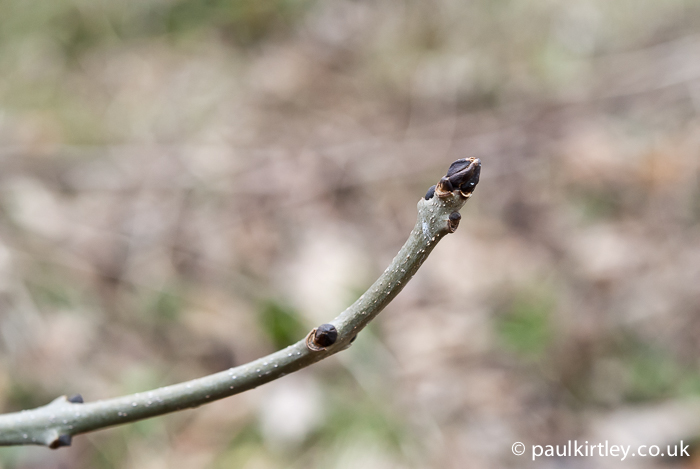
Alder or Common Alder – Alnus glutinosa
- The bark of a mature Common Alder, Alnus glutinosa. Photo: Paul Kirtley
Alders are a common riverside tree and are often associated with water. They can be found alongside streams and in areas that flood (‘alder carrs’). Alders also grow in damper spots where water is not apparent on the surface. The Alder’s native range is throughout Britain, mainland Europe, extending south to north Africa and east to the Caucasus and northern Iran.
Alder buds are often mauve in colour and oblong or ‘club-shaped’ with a length of around 7mm (0.3 in), on a short grey, scaly stalk.
The bark of Alder is purplish brown in young trees, darkening with age to grey-brown. In older trees fissures appear and the bark becomes cracked, creating small vertical plates in old trees.
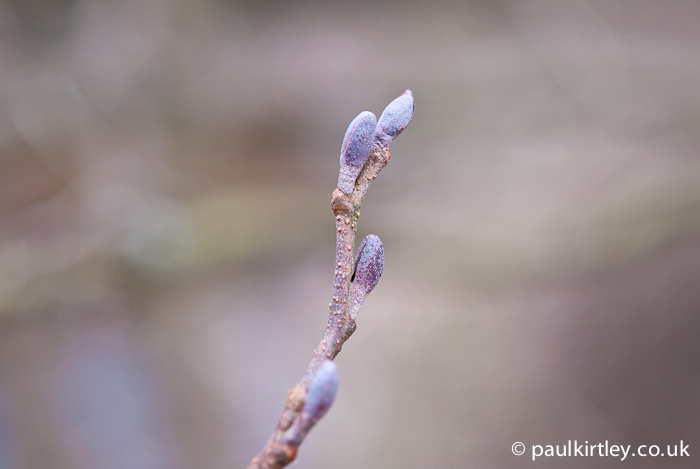
Silver Birch – Betula pendula
- The unmistakable bark of Silver Birch, Betula pendula. Photo: Paul Kirtley.
Silver Birch is found in forests, on sandy heaths, up on open hillsides and down in mountain valleys. It occurs all over Europe and into northern Asia.
The distinctive silvery white colour of the bark of Silver Birch is caused by the chemical betulin. In older trees the bark remains very silvery white in the upper section of the tree, but lower down develops black diamond shapes. Eventually the lower trunk develops thick, corky and fissures with dark grey-brown to black knobby plates and ridges. In young trees and, shoots of more mature trees, the bark is a shiny red-brown at first.
The buds of Silver Birch are small, 4-5mm (0.2 in), and egg-shaped. But in the case of Silver Birch you hardly need look at the buds – the rest of the tree is so recognisable.
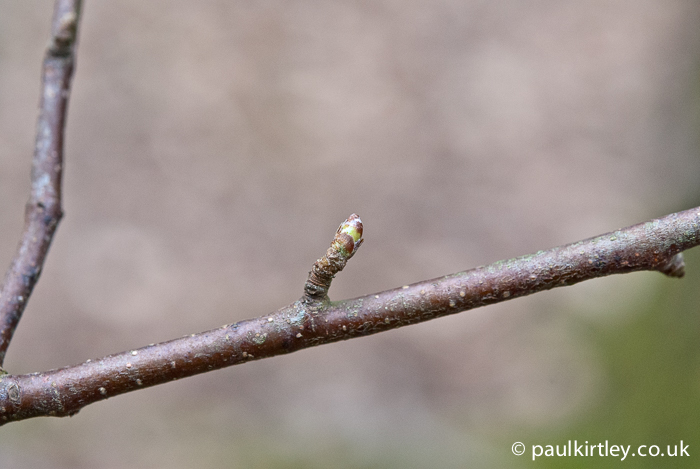
Hazel or Cobnut – Corylus avellana
- The bark of Hazel, Corylus avellana at different ages. Photo: Paul Kirtley.
Hazel is frequently found in hedges and under the canopy of larger trees in woodlands right across Europe. It typically grows as a small tree or a large bush, and its growth often reflects centuries of coppicing.
Hazel bark starts a light grey-brown, often with a bit of a sheen to it. The bark can be peeling in younger shoots but the peelings are quite fragile compared to the peelings of birch. Fissures can appear in medium sized growths but larger ‘trunks’ tend to have smooth grey-brown bark.
Hazel buds are short, blunt with green-red scales. The shoots are roughly hairy and quite distinctive.
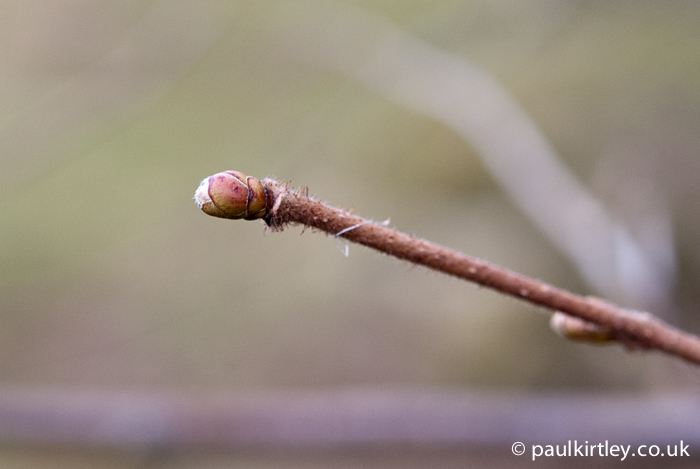
Hornbeam – Carpinus betulus
- Hornbeam, Carpinus betulus. Photo: Paul Kirtley.
The bark and buds of Hornbeam are similar to those of beech (see below) but Hornbeam doesn’t tend to grow into as large a tree. Hornbeam often grows alongside beech, but is better adapted to heavy, clay based soils. Hence, Hornbeam does well in parts of southeast England. Further afield, it grows across Europe and as far as Asia Minor.
The bark of Hornbeam is a silver to dark grey and generally smooth beech-like. Some people say it reminds them of the skin of elephants.
Hornbeam’s buds are 4-7mm (0.2 – 0.3 in) long, green-brown, sharp pointed and this latter feature particularly gives them some resemblance to the shape of beech buds (see below). But they are a different colour and while Hornbeam produces catkins in early spring, Beech doesn’t.
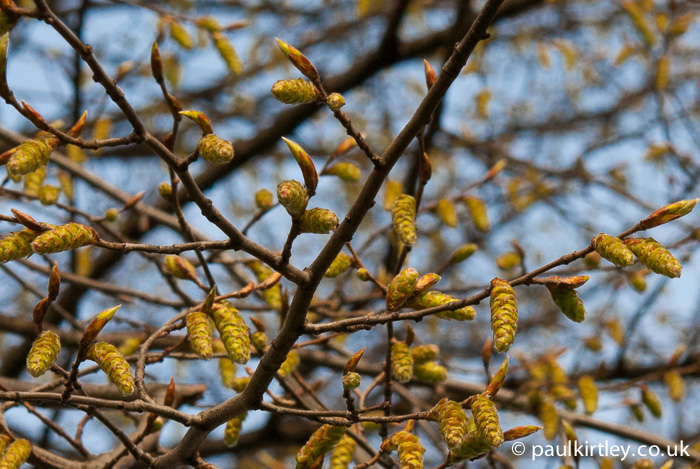
Beech – Fagus Sylvatica
- Beech, Fagus sylvatica, bark – younger in the foreground, older in the background. Photo: Paul Kirtley
Beech forms pure stands or is part of mixed woodlands right across Europe as far as the Ukraine.
The bark of Beech starts smooth and silvery grey. The bark only becomes a bit rougher in old trees, rarely becoming scaly and platy – certainly nothing as textured as mature Sycamore, Ash or Oak.
Beech buds have a long, thin and quite elegant spindle-shaped. 1-2cm (0.4-0.8 in) in length, the buds are sharp pointed and have a coppery-brown colour.
Often on younger trees and smaller branches of larger trees, you see dead brown leaves attached all winter.
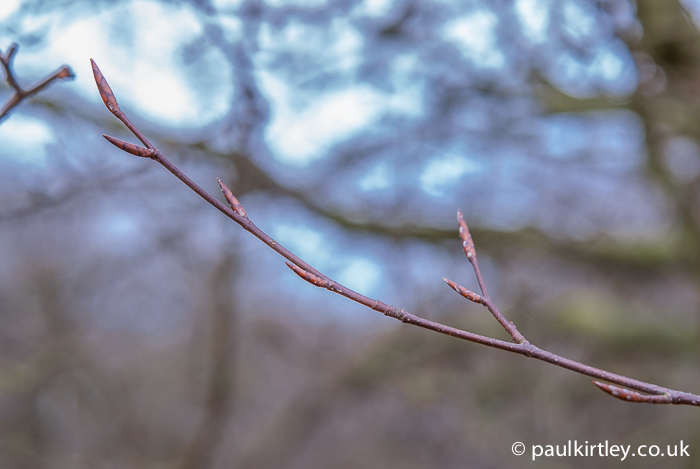
English Oak or Pedunculate Oak – Quercus robur
- The grey, criss-crossed bark of English Oak, Quercus robur. Photo: Paul Kirtley.
Widespread and common, the English Oak is the dominant large broad-leafed tree across much of Britain. Despite its name, however, English Oak also grows throughout Europe, as far east as the Caucasus. Oak often forms stands of pure forest.
The bark of young trees is smooth and grey-green. As the tree ages its bark develops more and more ridges and furrows, often cross-fissured into rectangular and hexagonal shapes.
The buds of English Oak range from egg-shaped with a blunt tip to egg-shaped with a more cone-shaped tip. The bud tips tend to be quite blunt and rounded. At the tips of the shoots the buds tend to be clustered. Buds are typically orange-brown and up to 5mm (0.2in) in length.
It can be difficult to tell the difference between English Oak, and Sessile Oak, Quercus petraea. If there are any dead leaves reamining, this can help – the leaf stalks of Q. robur are short and the leaf-lobes deeper, whereas for Q. petraea, the leaf stalks are longer. NB this is the opposite relationship to the stalks of the acorns – Q. robur’s fruit is on a long stalk or ‘peduncle’, whereas Q. petraea’s is on very short stalks or none (‘sessile’).
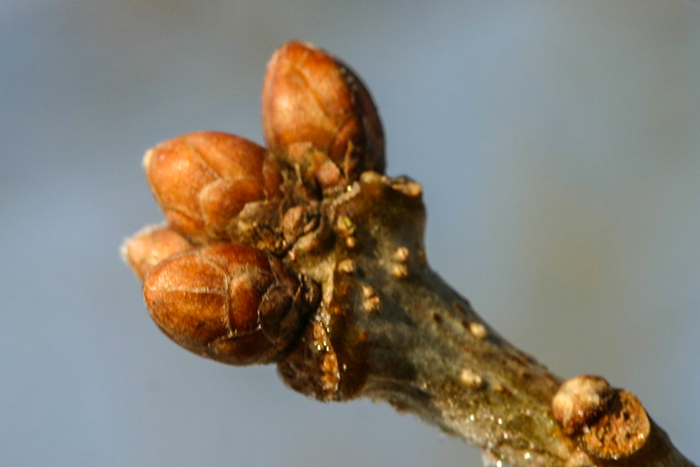
Goat Willow – Salix caprea
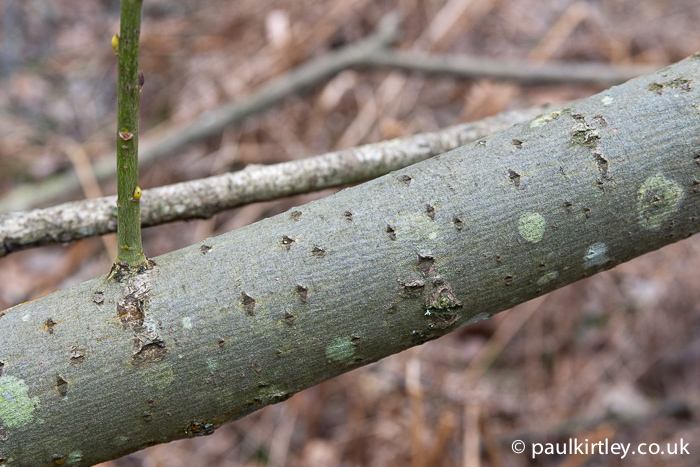
Willows can be confusing. There are 18 species native to the UK and over 400 species of Willow worldwide. And there are dozens of hybrids. One of the common European willows that is relatively easy to recognise is the Goat Willow and therefore a good place to start with learning to recognise willows. It is widespread and grows throughout Europe, often near to water. Goat Willow is also known as Great Sallow or Pussy Willow.
The bark of Goat willow is pale grey. To begin with the bark is banded with small diamond-shaped pits. Later the bark develops shallow, criss-cross ridges and can later develop orange fissures. Goat Willow’s buds are rounded and quite a shiny red or chestnut brown. They have only one scale and around 4mm (0.2 in) long.
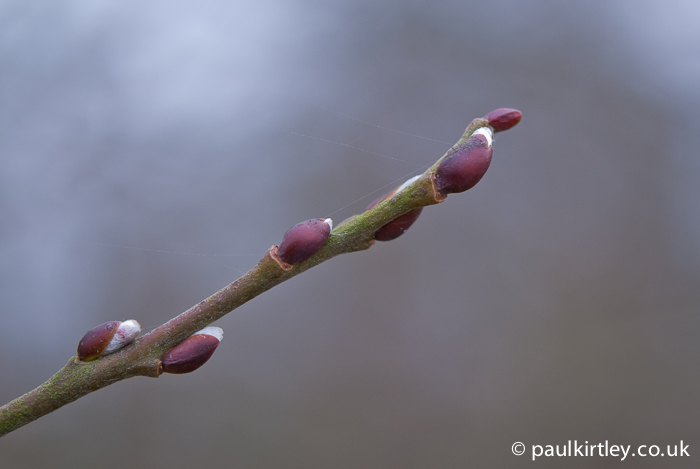
Elder – Sambucus nigra
- The corky bark of Elder, Sambucus nigra. Photo: Paul Kirtley.
Elder is very common and is found in hedgerows and woodland understorey. It is widely distributed throughout Europe, north Africa and western Asia. It usually forms a shrub but trees to 10m (33ft) have been recorded. It likes damp (rather than wet) places and especially likes nitrogen-rich soil. Some people consider Elder a weed. Even Richard Mabey describes Elder as a ‘mangy, short-lived, opportunist and foul-smelling shrub’.
Elder’s bark is a beige-grey. It is pretty unmistakable for anything else. The young shoots often have raised ‘warts’ while the older growth develops very rugged, corky ridges and furrows.
The buds on Elder are quite fun – they look like miniature pineapples. They have spiky scales and are purple in colour (a bit like red cabbage). They are arranged in opposite pairs and about 3mm (0.1 in) long.
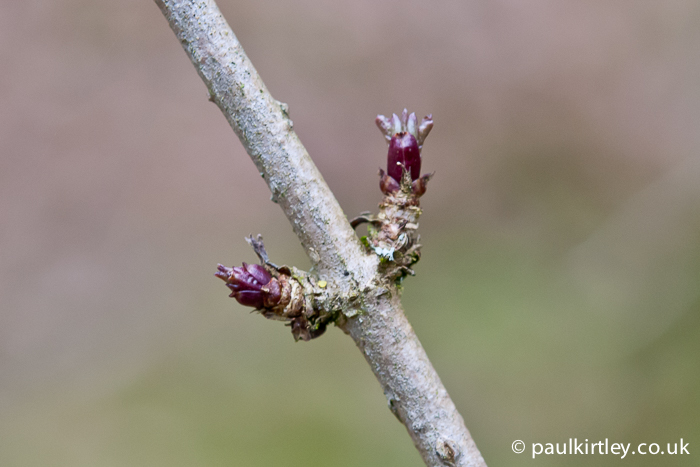
Rowan or Mountain Ash – Sorbus aucuparia
- Rowan, Sorbus aucuparia, bark. Photo: Paul Kirtley.
Rowan is a very common and widespread small tree of woodlands, open hillsides and mountains. In the right woodland conditions it can grow up to 20m (65ft) or so. It grows throughout Europe, east to the Caucasus and south into North Africa as far as the Atlas Mountains. Rowan is often called Mountain Ash, presumably because it is one of the last deciduous trees towards the treeline. It isn’t related to family of Ash, F. Excelsior, although it has superficially similar compound leaves.
Rowan’s bark is grey or silvery grey. It is often very smooth and can be shiny. On old trees the bark is duller, grey-brown can develop developing scaly ridges.
The buds of Rowan are pretty unremarkable. They are egg shaped with a bit of a cone-shaped tip. They tend to be grey with a hint of purple, with dense white hairs which are often brown at the tip. The buds grow to 1-1.7cm (04.-0.7 in).
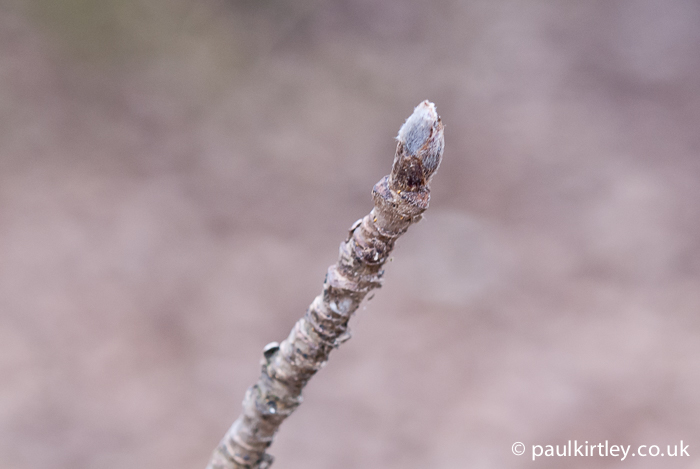
Wild Cherry – Prunus avium
- Wild Cherry, Prunus avium, bark. Photo: Paul Kirtley.
Wild Cherry grows throughout Europe, in North Africa, southwest Asia and as far east as western Siberia. Cherries like to grow in mixed woods, particularly oak woods.
In young or small Wild Cherry trees the bark ranges from greyish-pink to purplish-red and is typically shiny. In more mature trees the bark is purplish grey with prominent horizontal light-brown bands or lenticels. The bark can peel horizontal strips of bark (a bit like birches).
The buds are reminiscent of English Oak, Quercus robur. They are egg-shaped and bluntly pointed, dark orangey-brown, and up to 5mm (0.2in) long. Only the flower buds are clustered and these are not necessarily at the end of shoots or branches.
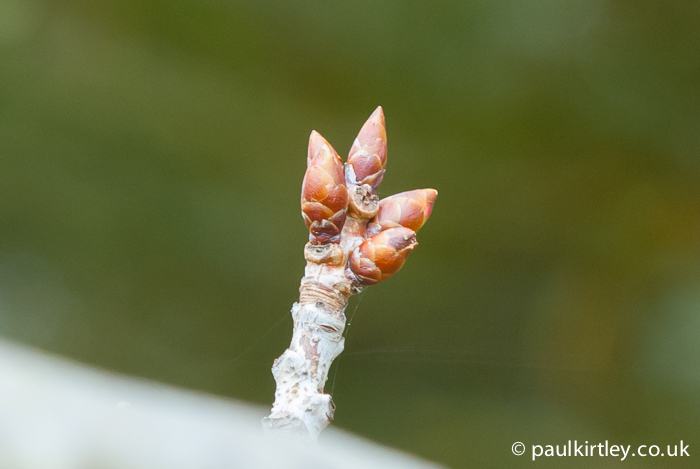
Learning to identify trees in leaf is certainly easier than without. But if you only learn to identify trees by their leaves in summer, you are only getting to know them in one mood and you are only getting to know one part of the tree. Learning about trees at other times of the year forces you to focus on other defining features.
If you take the time observe the flowers, fruit, seeds, bark and buds of a tree, you will not only be much better at identifying trees year-round, you learn about the tree’s full annual cycle. This study will give you a much greater insight into how all the seasons are connected and how for the tree, they flow from one into another.
The better you know the trees all year-round, the better you will be able to recognise valuable resources, and the more you will feel at home in the woods all year-round.
Improve Your Tree and Plant Identification Skills
At the heart of bushcraft is a practical study of nature. If you want to use the right resources for the job, whether making cordage or feeding yourself, you first have to learn to identify the right species. For these reasons, tree and plant identification has always been a core component of how I teach bushcraft and survival. I have a dedicated online training course in tree and plant ID for bushcraft and survival. Enrolment opens once per year. If you’d like to find out more, click here: Tree & Plant Identification Masterclass details.
Related Material On Paul Kirtley’s Blog
Labrador Tea – Tonic or Toxic?












86 thoughts on “Bark & Buds: How to Easily Identify 12 Common European Deciduous Trees in Winter”
Hi Paul,
Again a nice article! I like your blog because you really talk about bushcraft and not only survival, like most other blogs.
Hi Joep
Thanks for your comments again. Good to see you back. I’m glad you understand where I’m coming from with my blog – at the heart of bushcraft is a knowledge of nature.
All the best
Paul
A timely article Paul, I’m off work next week and will certainly be spending several days out in the woods. I remember being on my fundamental Bushcraft course, although it was mid April spring hadn’t really sprung and it was quite difficult as a novice to ID the trees we needed to know about. We’re all much more familiar with our trees in summer when the leaves are out. I’ll take a printed copy out with me and see if I can learn to recognise any ‘new’ trees and check on what I think I already know.
Hi Steve
That was a tough place to start on your Fundamental – learning to ID new trees in late winter/early spring. But your ID will be all the better for it. That you were in April with little sign of spring also demonstrates an important point – from the perspective of ustilising your bushcraft skills, if you can’t recognise the woodland resources without leaves on the trees, then you are handicapped for 4 or 5 months of the year.
Enjoy your week off next week!
Paul
Superb pictures and detail.Many books and botanical references show trees with their leaves and fruits.Addressing tree id in winter is rarely covered and not with such relevant photos.Good idea. I think I am going to start printing off these ‘articles’ and compiling them in a file – excellent references !
Thanks
Hi Mark
Thanks for your comment. As you say, there are some really good tree guides out there but as you say, they often don’t focus on winter ID. Also, encyclopaedic tree guides can be very daunting for those not already familiar with common species – you simply don’t know where to start! What I’ve tried to do with this latest article is provide a starting point.
All the best
Paul
Smashing article. Excellent quality pics.
Great article Paul! Only knew 4, very helpful. I think I’ll have to keep coming back for reference!
Nige.
Hi Nige
Good to see you here. Thanks for the comment. I’ll be writing more on identification throughout the year so please do pop back and have a look.
All the best
Paul
Great article Paul and very useful.
As Nigel said it’s going to be as good reference to come back to. Hopefully you’ll do some more trees for us.
Hi Steve
It’s good to hear from you and I’m glad you found this article useful. I will be doing some more on trees.
All the best
nice article Paul, my knowledge of uses is fairly limited, could you possibly list some uses for the various trees ie birch for tinder or sap, willow for cordage, carving, cooking, friction fire etc
thanks
Hi Dano
Welcome back and thanks for your comment. I made a conscious decision to focus just on ID in this article as otherwise it would have become huge. That said, I will be covering uses in future articles. Some uses are quite specific to the species (your example of tapping birch for sap for example) and probably deserve a separate article in themselves. Let me know over time if you are getting the information you need.
Thanks and all the best
Paul
Good article. great photos. i agree that a lot of tree ident. books only show summer pictures, so this is invaluable. i too will have to start printing the articles off.
Hi Rivka
Welcome and thanks for commenting. The Bark & Buds piece has received very positive feedback. Thanks for adding to it. I’ll certainly be doing more on this subject in future.
All the best
Paul
great blog, thanks for taking the time to write it, hard to find good info
Really helpful article – especially to a horti student who has a live tree ident on Wednesday – we’ll just get buds and photos of the bark, so this will ensure I get at least some right!! Thanks Paul!
Thanks Claire and good luck on Wednesday!
Excellent article; it was applicable up to a fortnight ago around here but things have moved on to the next stage and I’m getting confused again 🙂
Hi Tim
Thanks. Yes, looking back at the photos in this article makes you realise how rapidly the countryside has changed in the last few weeks. I’ll add some leaf-ID to my list of things to write about 🙂
All the best
Paul
Hello Paul
Very good and timely article, good simple and clear information on commonly found trees, some of which can be problematic to identify in winter.
For additional information I also use the woodland trusts website It is often aimed at children so it is simple and clear (even I can understand it).
Great review of the tree’s, many are here in BC as well. Great artical Paul. Cheers
Another very informative article, I like tree spotting in the winter and spring and you have covered some of the commonly ignored spices that can be frequently found in woods and hedgerows. Leaf ID will also be great and not just the summer foliage.
I am always amazed at the changes in Trees, they are worth watching as the weather changes, they are usually subtle and can be missed easily.
I’m glad you mentioned that willows can be hard to get to grips with ID wise, I thought I was just being lame 😀 I try and get to grips with the trees that grow near me so that once I’ve spotted them in the summer I can observe them when they are without leaves.
Hi Austin,
Yep, willows can be very difficult to pin down, even in summer when they do have leaves. Hybrids are the issue.
That said, in terms of uses for bushcraft and survival – friction fire-lighting, feathersticks, cordage, withies, fish traps, baskets, medicine, etc – as long as you know it is a willow, you don’t necessarily need to know the species.
I think you make a good point though – and one that can be applied in general, not just to willows – get to know the trees in your area throughout the year. Observe their features at each stage of their annual cycle and link them together in your mind.
All the best,
Paul
I really loved your well-illustrated guide. Trees (and shrubs) are as beautiful in winter as they are any other time of year. I admire your simplicity of expression and your obvious affinity with all that grows where it wants to.
Hi Jacqueline,
I love your comment “Trees (and shrubs) are as beautiful in winter as they are any other time of year.”
I think there is something great about looking at a fully-formed bud in winter and contemplating the potential that will soon spring forth. Then, when the leaves do come, I enjoy the rapidity with which everything changes.
Warm regards,
Paul
I really appreciate this article Paul. As someone who has struggled with low mood during the last few winters I have been making an effort to pay more attention to trees in winter this year, when for the first time I too had the realisation that spring’s leaves are kept tightly wrapped all through the winter just waiting for the right time to start the cycle all over again. I find this really comforting and a source of great optimism. I will definitely be using this page to help me appreciate winter trees even more, many thanks
I’ve linked to this page from my blog http://wintermoodproject.wordpress.com/
Good stuff.
I really like your article. I have been carrying around a kid’s book, the I-Spy book of Trees and struggling a it to identify trees and began taking picture so the bark to see if that helped so your article has proved extremely useful, many thanks.
Hi Jane,
Thanks for your comment. It’s nice for me to read that this article has been so helpful to you.
Please keep in touch and if you have difficulties in identifying anything, you know where I am.
Warm regards,
Paul
Hi to all ,
I would really appreciate any help anyone can give me on plants for bedding display need pics and info also im trying for 20 plus plants for small gardens 20 also and 5/6 for soil types for plants any websites pics or ideas ..Thankyou
Kind Regards ,
Declan Rooney
Hi. I love your photos. Can I use your picture of the buds (The attractive, mauve buds of Common Alder, Alnus glutinosa. Photo: Paul Kirtley.) to teach primary school children in Bristol about tree id and the history and uses of trees please? I’ll try and take my own pics, but running out of time!
Hi Mellie, yes no problem.
Warm regards,
Paul
Came across your blog by accident and thought that your pictures of bark and buds for winter tree identification were really good. Very clear and crisp. Better than some text books.
Thanks Ian. I’ve taken a lot more this winter. I hope to share them at some point.
Warm regards,
Paul
What are the Wobbly trees that have orange twigs growing upwards from them they are so amazing never seen them before x
Hi Melanie,
Do you have a photo you could share?
Your description could be of various different species.
Warm regards,
Paul
A really great, informative article, coupled with some clear photos.
Better than a lot of tree identification books.
Many thanks!
Hi Rich,
Thanks for your message. That’s kind of you – I’m glad you found it useful.
Warm regards,
Paul
Hi Paul,
Another fantastic post, thank you!
Especially useful as I have a tree and plant identification test as part of my interview for the bushcraft instructors course.
Very nice photos and very informative!
Many thanks,
Joe Garnett
Hi Joe,
Thanks. I hope it proves useful to you.
Is the interview with John Rhyder?
Cheers,
Paul
Paul,
Yes it is.
Joe
Good choice of instructor Joe. I hope it goes well for you.
All the best,
Paul
As a novice morel mushroom hunter this is information is very useful, especially the ash. Now if you could add elm and tulip poplar i would be in great shape. Thanks!
Hi Adriana,
Judging by your wishlist of trees, I guessed you are in the USA. Then I looked at your IP, which suggests Georgia. Is that right?
Warm regards,
Paul
Georgia is correct, Paul.
I do have a problem with winter ash identification. Those black buds are so high up you need binoculars to see them ! And the checker-plate bark pattern still eludes me.
Hi again Adriana,
While we don’t have the same species of ash in northern Europe as you have in Georgia (white, pumpkin, green and Carolina is my understanding), the following article may be helpful with some of the general Fraxinus features: http://paulkirtley.co.uk/2013/how-to-identify-an-ash-tree/.
Warm regards,
Paul
Hi
Thanks for this web site. I am trying to identify a tree with composite leaves, leaves opposite each other, and one at the end for a total of 13. The leaves have a smooth edge and are very pointed, but about 1 and 1/2 inch to 2 inch wide at the most. There are two trunks side by side, but I can’t tell if it is one tree or two. The trunk ridges have a horizontal break every three to five inches up and down the tree. I can send pictures if I had your e-mail address. Thanks,
Tom Janson
Hi Tom,
Please send some images through to paul at paulkirtley.co.uk
Information on where you saw the tree would be useful too – place and type of habitat.
Thanks,
Paul
Hi Paul,
Thank you for this fantastic post. Great photos and uncommon description of the winter appearance of some widespread tree species.
When I learn new plant species I usually make my own field guide by printing high resolution images from these beautiful antique books:
http://biolib.mpipz.mpg.de/thome/index.html (from the year 1885)
http://caliban.mpipz.mpg.de/sturm/flora/index.html (from the year 1796)
If you click on the botanic name of a species you get a medium resolution image but if you scroll to the bottom an click “Hochaufgeloestes Bild” (high resolution image) you get amazing beautiful prints for your personal field guide. If you frame them they make for a wonderful christmas present too. 🙂
There is only one thing you have to take care of: the German and Latin botanic names are according to the original works and therefore outdated in some cases. For my self-made field guides I usually make a list with the modern taxonomy as a table of contents.
All the best, a merry Christmas and a happy New Year.
Michael from Austria
Paul,
This perhaps one of your posts I have enjoyed the most. I live on the edge of woodland (the Forest of Dean), and have struggled to identify trees when they are not in leaf. I have added some of your observations to my Collins Gem guide, which usually goes with me on walks; I think that your comments and photos should make ID much easier.
Best wishes,
Philip.
Very helpful guide! I am doing my Level 3 Forest School training, and need to produce a ID guide for the children to use, and due to the time of year, this will need to focus on bark and buds- would you mind if I used your pictures in this? Obviously I would credit them appropriately and would be happy to share the finished guide.
Hannah Rhodes
Thank you … clear and simple, perfect! Great pictures too.
My pleasure David. Glad you found it useful.
Hello , i found some sort of leguminous tree with small thorns in Poland, dead branch had wood ear fungi growing on it. Any idea what it could be? some species of acacia is my rough guess.
Would you be able to send some photos Jeremiah?
I have a large ash tree with two large trunks, Y shape. One truck appears healthy and produces many leaves. The other has lost its bark for some reason, maybe to termites. Both are approximately 18 inches diameter and about 15 to 20 feet tall. Will I have to take the entire tree down? I’m afraid that if I cut the dead trunk down the entire tree will fall since one side will be heavier and uneven.
Hi Paul,
Im really struggling to ID a small tree. Now it is spring it makes it more difficult for me a leaves are not large enough. I use the tree id apps and I have a copy of the tree guide. I Couldnt find it, however I’m sure its in the sources. Would you recommend anything. Could I poss send you a couple of pics for you to look at. Sorry to be cheeky 😉 http://www.westbeams.co.uk/tree-surgeon-3/tree-surgeon-southampton/
Thanks for your time and great post by the way.
Oli
Hi Paul your approach to woodland knowledge and bush craft is far greater than mine. I spent two years taken six thousand photos of three hundred and forty species of trees. The purpose was to have in as many photos of each species the bark with all that tree shows in season eg leaves shrubs twigs fruit and seeds placed against the bark shown all you need to know when your in the field. Your web page is developed and wonder if my photos which are all titled in the bottom right hand corner by there every day name and not in Latin would be relevant to your teaching and courses.
Hi Kenneth,
Thanks for your message. That’s quite a project you’ve undertaken.
I do have a lot of photos of my own, as you can imagine, but the portfolio is certainly not complete when held up against all the species present, even in the UK.
From time to time, I do need to search out photos from other people to illustrate articles and other content. You will certainly be one of my first ports of call in future should I need to source a photograph.
I have your email now, so I’ll drop you a line if needed.
Thanks again for your kind offer. And keep on enjoying your exploration of nature…
Warm regards,
Paul
Hi Paul, This is very helpful. I’ve just bought some land and need to identify the trees without their leaves as I know there’s a sycamore in there somewhere which I need to cut down as it’s highly poisonous to horses! I wonder, do you have a downloadable version I could print out please?
Thanks, Lucy
Hi Paul, This is very helpful. I’ve just bought some land and need to identify the trees without their leaves as I know there’s a sycamore in there somewhere which I need to cut down as it’s highly poisonous to horses! I wonder, do you have a downloadable version I could print out please?
Thanks
Hi, Paul,
Thanks for another useful article: it has helped with my current wanderings in the local woods with Scouts.
There’s a useful resource at the Woodland Trust that readers might find useful: http://www.woodlandtrust.org.uk/naturedetectives/activities/2015/09/twig-id/
Keep posting the info!
All the best,
Rob
just really really good stuff. thank you! 🙂
🙂 You’re very welcome David. Thanks for the feedback.
Warm regards,
Paul
Hi Paul,
You just answered my question .. Clearly 🙂
Nice one, thank you for your article 😉
Lorraine
Hi Lorraine,
I’m glad to have been of assistance via this article 🙂
Thank you for taking the time to leave me some feedback. I greatly appreciate it.
Warm regards,
Paul
Hi Paul
Great feature I think tree id is one of the most difficult things to do,not so much in the id but remembering each one
This will help me produce a few bullet points to assist when out,thanks
Hi Dave,
Thanks for your comments. I’m glad this article was of value to you. Enjoy roaming the woods 🙂
Warm regards,
Paul
VMTX, Paul, for a very informative article. Suggested amendment to your text on Alder/Common Alder, para 1, last line “….south to north Africa and west (!!??) to the Caucasus…..”
Peter,
It amazes me a) I wrote this silly transposition in the first place, b) I didn’t notice it when I proof read the article and c) it has taken someone 5 years to point out the mistake 🙂
Thanks for your diligence, however, and for taking the time out to let me know.
Warm regards,
Paul
Glad to be able to help, Paul. I too have learned the hard way not to trust my own proof-reading. Keep up the good work.
Peter
Thanks Peter 🙂
Hi Paul,
Thank you for such an informative and useful blog.I collect buds& flowers from trees when I can for flower remedies. I am finding it difficult to find any beech buds .any idea of best time or locations.
Thanks
Olive
May I simply just say what a relief to discover somebody who truly understands what they are discussing over the
internet. You certainly understand hhow to bring an issue to light aand make it important.
A lot more people should check this out and understand this side oof your story.
I was surprised that you’re nnot more popular because you surely have
the gift.
Good blog Paul that I stumbled on. I was researching what kind of young tree I had that grew on its own. Originally I thought it was a beech, but now after reading your blog perhaps it’s a hornbeam. Do you know if hornbeams grow in eastern Canada – Nova Scotia?
There is little information about identifying young trees on the web. Might make another interesting blog topic. Even some of the mature tree identification sites can cause confusion. For example, I have this old stand of trees that I have always thought were sumac. The leaves seemed to match what I found online pretty well. Now that it’s very late summer, one site said sumac berries make an excellent drink that they called “sumac-ade”. I thought I might try it.
I gathered a bunch of the red berries, but first of all bit into one. It definitely tasted wild and bitter, and I had visions of being poisoned and having to be rushed to hospital.
My first stop was at my computer to more fully identify this berry and found it to be a rowan berry. I had rowan trees, not sumacs! Luckily, I found out that rowan berries are not poisonous, but jam-packed with vitamin C which probably explains the bitterness. Another topic could be on the uses of tree berries. I just found out my russian olive fruit makes great jam.
Thanks again!
Hello there I am so delighted I found your web site, I really found you by
error, while I was searching on Aol for something else,
Regardless I am here now and would just like to say thanks for a incredible post and a all round exciting blog (I also love the theme/design), I don’t have time to
look over it all at the minute but I have book-marked it and also added your RSS feeds, so when I have time
I will be back to read a lot more, Please do keep up the fantastic work.
Really appreciated your definitions of common trees in the winter. I live on coastal British Columbia and having a difficult time persuading people that the Rowan tree berries will make good jelly! I keep being told that it is a mountain ash and not edible! So now I san assure people that it is OK to eat. Thanks for the very explicit pictures.
Marian
Thank you! I am a townie moved to the countryside a lifelong dream but identifying the trees around me has been tough, knowing what to look for on trees in winter is brilliant. You can see so much more of the tree itself without leaves and I find them rather beautiful.
I don’t know why even bother to google anything, if this blog is always the best result I get!
Thanks for this great read. It is so helpful to find so well described (as in opposition to 99% of Internet) set of most common (as in opposition to 1600 positions in Collin’s guide) trees.
Hi Paul, please help me. I have some lovely wood that I will turn on my lathe, I got the wood from the council, a recently felled tree, but I can not identify it. I have re-visited the tree site and can not find leaves or seeds or any evidence except branches, young and old, with buds and bark.
I have put my pics of it up, please help!! -https://www.flickr.com/photos/143544303@N08/
Thanks so much for this super helpful resource – looking forward to using it with my kids as we try to ID trees in winter.
Wonderful. Thanks for letting me know Rachel. I hope you and your kids have fun identifying trees this winter.
Warm regards,
Paul
As a longtime follower and distant student of your courses, it is clear why Frontier Bushcraft is chosen #1 on the net. Life is busy and there’s only so much time to devote to studying topics of interest. The wealth of education that you put forth and that is available to this community, makes it very simple as to where to focus my time and attention to consistently access “reliable” information I am interested in. No theory here. All from personal, practical experience. To be honest, the information and education you provide is 2nd to none and really almost eliminates the need to search for any other alternative source on the topics of bushcraft, survival, wilderness skills, identifying and utilization of natural resources. Massive library right at our fingertips.
So happy with the first two online course modules, I’m now greeting our woodland bits with a smile. Glad to be under the wing of the Paul Kirtley Learning.